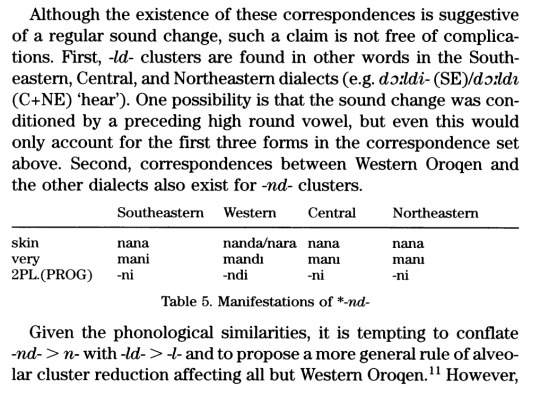Don't wanna be here? Send us removal request.
Text
Nivkh is a very small language family, its varieties are quite close to each other. How can anything possibly go wrong with the reconstruction?



25 notes
·
View notes
Text
Alexander Vovin “Towards a New Classification of Tungusic Languages” (1993)
This paper [Vovin, Alexander. "Towards a new classification of Tungusic languages." Eurasian Studies Yearbook 65 (1993): 99-113] is an attempt at a lexicostatistical classification of Tungusic. Based on percentages of cognates in 100 word Swadesh lists, Vovin proposes the following classification:

A strikingly unusual feature of this tree is the position of Even as the second language to branch off after Manchu. Usually, Even is placed in the same branch with Evenki, Solon, Oroqen and Negidal.
Indeed, Even mostly shows lower cognate percentages with other Tungusic varieties than any other language save Manchu:

It would be interesting to check the accuracy of Vovin’s wordlists, but I will not try to do it here. Instead, we can look at some of those items of the Swadesh lists where Even differs from other languages. These are the very items which cause lower cognate percentages.
‘blood‘: Even huneel [actually huŋeel] vs. reflexes of *sääksä in all other languages (Manchu senggi contains a different suffix, but has the same root)
‘bone‘: Even ikeri with a cognate in Negidal vs. reflexes of *gïramsa in all other languages (Manchu giranngi contains a different suffix, but has the same root)
‘die‘: Even køke= vs. reflexes of *bö(d)- in all other languages, including Manchu
‘drink‘: Even kool= vs. reflexes of *umï- in all other languages, including Manchu
‘ear‘: Even korat with an apparent cognate in Udihe vs. reflexes of *sian in all other languages, including Manchu
‘full‘: Even milteree vs. reflexes of *ǯalo- in all other languages save Udihe
‘sleep‘: Even huklee= vs. reflexes of *au- in all other languages, including Manchu
‘sun‘: Even nøølten vs. reflexes of *sigöön in all other languages, including Manchu (Evenki, Solon & Negidal also reflect another root: *dïlačaa)
This is not a pattern we would expect from a second outlier in the family. One could rather expect that Even would share some archaisms with Manchu as against innovations in the common ancestor of all remaining languages. There are no such cases in the Swadesh list. Instead, we see Manchu sharing common words with the rest of the family except Even. Given that Manchu is the first outlier in Vovin’s classification (as well as in most other classifications), words shared by Manchu with other languages are by definition archaisms, while isolated Even words must be innovations.
The position of Even in Vovin’s tree is clearly erroneous. The reason for this error is the fact that lexicostatistics does not distinguish between archaisms and innovations, so that a lexically innovative language may look like an outlier in a family.
30 notes
·
View notes
Text
Lindsay J. Whaley and Fengxiang Li “Oroqen Dialects”
This paper surveys some dialectal data from Oroqen varieties. Authors conclude that Oroqen can be divided into the following four dialects: Western, Central, Northeastern, and Southeastern.
One of the phonological developments distinguishing Oroqen dialects is what Whaley & Li call “manifestation of *-ld-”:

At first sight it seems like *-ld- is simplified to -l- in all dialects, save Western. However, things are somewhat more interesting.


This discussion shows a lack of familiarity with the most basic facts of Proto-Tungusic reconstruction. The words in Tables 4 & 5 do not reflect Proto-Tungusic *-ld- and *-nd-. Instead, they reflect *-ls- and *-ns-! Cf. the following Proto-Tungusic reconstructions (I use Doerfer’s system here, but the correspondences for *ls and *ns were recognized as such already by Tsintsius): *ölsä ‘meat’, *pulsa ‘quilt’, *nansa ‘skin’, *mansï ‘very’, *-nsi ‘2 sg’ (2PL in Table 5 must be a mistake) vs. *dooldï- ‘to hear’. The verb ‘to sing’ is more complicated: apart from Oroqen, it has reflexes in Ewenki, Solon and Ewen (thus, only in North Tungusic), and the Proto-North-Tungusic form can be reconstructed as *ǯaandaa-. However, one of the common North Tungusic innovations is the simplification *-nd- > *-n-, so Proto-North-Tungusic *-nd- must have a different source. Perhaps, this word is a loan from unknown source, borrowed after the change *-nd- > *-n-.
An interesting feature of Oroqen is its symmetrical vowel system with tense (+ATR) / lax (-ATR) pairs:

Southeastern Oroqen differs from other dialects by merging /i/ and /ı/:

The authors point out that “An even more dramatic restructuring of the vowel harmony system has occurred in most Tungusic languages. Only Oroqen and Solon seem to have preserved a perfect symmetry between tense and lax pairs, except now for the Southeastern dialect, where the system is moving toward asymmetry”.
Indeed, Proto-Tungusic is reconstructed with a very similar symmetrical system: +ATR *i, *ii, *ü, *üü, *ä, *ää, *ö, *öö, vs. -ATR *ï, *ïï, *u, *uu, *a, *aa, *o, *oo + some diphthongs. A common innovation of North Tungusic languages (including Oroch and Udihe) is a change *ü > *i, *üü > *ii, so Oroqen symmetrical system cannot directly continue the Proto-Tungisic vocalism. While Oroqen /u/ continues Proto-Tungusic *ö (e.g., in Oroqen urə ‘mountain’ < PT *xörää ‘id.’), the origin of Oroqen /o/ remains unclear to me. Oroqen words cited in the article do not contain this phoneme.
25 notes
·
View notes